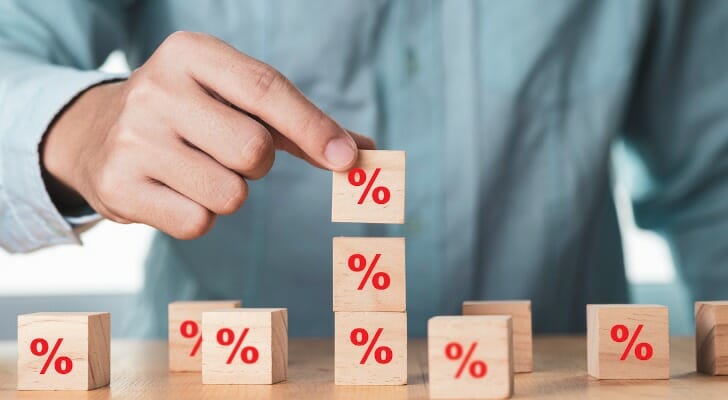A forward rate can be one of two things. In most usage, forward rates estimate the interest that an investment or loan will pay in the future. You can use it to predict the yield you will get on a given investment based on the spot rate or yield curve that the investment currently offers. In less common usage, the term “forward rate” can refer to a contract agreeing to a specific interest or exchange rate in the future. In this case, the two parties have agreed to a rate that they will use for a future transaction in order to avoid unpredictable market dynamics. Here’s how it works. You may also want to talk to a financial advisor to see how it impacts your personal situation.
What Is a Forward Rate?
In broadest terms, a forward rate is a rate that will apply to a financial transaction in the future. Most of the time this refers to an interest rate, such as with a bond or banking product, but it can occasionally refer to currency exchanges as well. There are two ways that investors apply the concept of a forward rate.
1. Cross-Currency Transactions
Sometimes, investors will use the idea of a forward rate in the context of hedging. In this case, forward rate refers to the terms of a contract that involves interest-bearing products or (more often) cross-currency transactions. The parties will agree to a forward rate, meaning they agree to a rate that they’ll use for interest or currency exchanges in a deal that is to take place in the future.
For example, say that a business in Britain (on the British pound) wants to borrow money from a bank in France (on the euro) in six months. However, they don’t know what the rate of the pound will be against the euro at that time. They might agree to a fixed exchange rate for their transaction, eliminating currency volatility as a risk in this loan. The terms of their deal would set a forward rate, defining their exchange rate in the future. This is also referred to as a forward exchange rate.
2. Investment Transactions
Most of the time, however, forward rate refers to estimating the interest rate you might get on an investment product in the future. For example, you might have a one-year bond that currently pays 3% interest. You might want to estimate what interest rate that bond would pay and so what yield you would receive, in six months. This would be the bond’s forward rate.
This is the corollary to the spot rate, which is the interest rate you would receive from an asset as of today. Forward rates are generally used to predict short-term assets because ultimately this is an estimation. The further you try to forecast an asset’s future interest rate, the less accurate any prediction will get.
Calculating Forward Rates

You calculate a forward rate using one of two data sets:
- The Yield Curve:The interest rate between bonds of different maturities, often used to evaluate government bonds
- The Spot Rate: The current rate that a bond pays if you bought it today
In either case, you need basically the same data. What does the asset you want to buy pay today and what does a comparable asset pay over a longer term?
The most common example of forward rates involves Treasury bills. Say that you have two options: First, you can buy one, 12-month Treasury bill. Second, you can buy a six-month Treasury bill and then, once it expires, roll that money into a second six-month Treasury bill.
You know what you will make with the 12-month asset and you know what you will make in the first six months. If interest rates will go up, then you’re better off buying two six-month bills and taking advantage of that future, higher, interest payments. If rates will go down, then you’re better off buying a 12-month bill and securing your rate now. The forward rate is an attempt to estimate what those six-month bonds will pay when you buy them in the future, so you can make an informed decision.
The standard formula for a forward rate is as follows:
- FR = [ (1+Ra)^a / (1+Rb)^b] – 1
Where:
- FR = Forward Rate, the future yield that you’re trying to predict on the underlying asset
- Ra = The rate on the asset over a period a
- a = The future period of time over which you’re trying to estimate rates
- Rb = The rate on the asset over period b
- b = The period of time that you’re using as a point of comparison
In addition to working best over short periods of time, forward rate predictions also work best with zero-coupon assets. This clarifies your yield more effectively than assets where the yield comes from its coupon rate.
Let’s return to our Treasury bill example. Say that we’re looking at a one-year Treasury bill vs. a two-year Treasury note. The one-year bill pays 4.1% and the two-year note pays 4.5%. We would like to estimate, essentially, which is the better option: Investing in the two-year note and holding our position or investing in the one-year bill and rolling the money over into another one-year bill when it matures.
To calculate that our formula would be:
- FR = [(1 + 4.5%)^2) / (1 + 4.1%)^1] – 1
The first section of our formula is the future bond rate that we’re using as a basis for estimation. The second section is our current shorter-term bond rate that we’re trying to estimate going forward.
- FR = (1.045^2 / 1.041^1) – 1
- FR = (1.092 / 1.041) – 1
- FR = 1.048 – 1
- FR = 0.048
- FR = 4.8%
Our forward rate is 4.8%. This means that investing in the two-year bond will give the same yield as if we invested in one year bond at its spot rate, 4.1% and then rolled that money over into a second one-year bond at a rate of 4.8%. This allows us to estimate that rates on the one-year bond will likely rise in order to catch up with that difference.
The Bottom Line

An investment’s forward rate predicts the future yield you will get by investing in an interest-bearing asset. It’s the corollary to the spot rate, which tells you the rate you will currently get from an asset. You can also work with a financial advisor to help you determine your best course of action.
Interest Investment Tips
- A financial advisor can advise you on whether it makes sense for you to use interest investing as part of your portfolio to help you reach your goals. Finding a financial advisor doesn’t have to be hard. SmartAsset’s free tool matches you with up to three vetted financial advisors who serve your area, and you can interview your advisor matches at no cost to decide which one is right for you. If you’re ready to find an advisor who can help you achieve your financial goals, get started now.
- Bonds really are an excellent investment, even if they’re less flashy than stocks. Here’s how to make them part of your portfolio.
Photo credit: ©iStock.com/Dilok Klaisataporn, ©iStock.com/Zinkevych, ©iStock.com/SDI Productions
